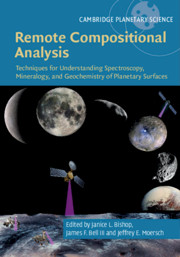 Remote Compositional Analysis
Remote Compositional Analysis Book contents
- Remote Compositional Analysis
- Cambridge Planetary Science
- Remote Compositional Analysis
- Copyright page
- Contents
- Contributors
- Foreword
- Preface
- Acknowledgments
- Part I Theory of Remote Compositional Analysis Techniques and Laboratory Measurements
- Part II Terrestrial Field and Airborne Applications
- Part III Analysis Methods
- 13 Effects of Environmental Conditions on Spectral Measurements
- 14 Hyper- and Multispectral Visible and Near-Infrared Imaging Analysis
- 15 Thermal Infrared Spectral Modeling
- 16 Geochemical Interpretations Using Multiple Remote Datasets
- Part IV Applications to Planetary Surfaces
- Index
- References
13 - Effects of Environmental Conditions on Spectral Measurements
from Part III - Analysis Methods
Published online by Cambridge University Press: 15 November 2019
- Remote Compositional Analysis
- Cambridge Planetary Science
- Remote Compositional Analysis
- Copyright page
- Contents
- Contributors
- Foreword
- Preface
- Acknowledgments
- Part I Theory of Remote Compositional Analysis Techniques and Laboratory Measurements
- Part II Terrestrial Field and Airborne Applications
- Part III Analysis Methods
- 13 Effects of Environmental Conditions on Spectral Measurements
- 14 Hyper- and Multispectral Visible and Near-Infrared Imaging Analysis
- 15 Thermal Infrared Spectral Modeling
- 16 Geochemical Interpretations Using Multiple Remote Datasets
- Part IV Applications to Planetary Surfaces
- Index
- References
Summary
An ever-increasing number of laboratory facilities are enabling in situ spectral reflectance measurements of materials under conditions relevant to all the bodies in the Solar System, from Mercury to Pluto and beyond. Results derived from these facilities demonstrate that exposure of different materials to various planetary surface conditions can provide insights into the endogenic and exogenic processes that operate to modify their surface spectra, and their relative importance. Temperature, surface atmospheric pressure, atmospheric composition, radiation environment, and exposure to the space environment have all been shown to measurably affect reflectance and emittance spectra of a wide range of materials. Planetary surfaces are dynamic environments, and as our ability to reproduce a wider range of planetary surface conditions improves, so will our ability to better determine the surface composition of these bodies, and by extension, their geologic history.
- Type
- Chapter
- Information
- Remote Compositional AnalysisTechniques for Understanding Spectroscopy, Mineralogy, and Geochemistry of Planetary Surfaces, pp. 289 - 306Publisher: Cambridge University PressPrint publication year: 2019
